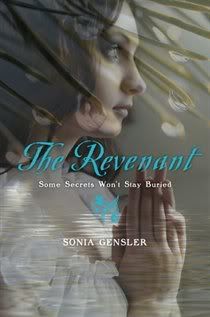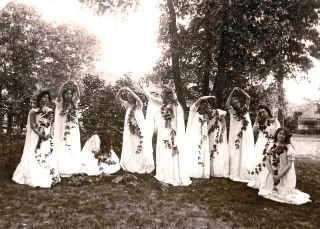Hi everyone! Please join me in welcoming Sonia Gensler, author of THE REVENANT (Knopf), to our blog.
Nothing prepares her for what she finds there. Her pupils are the daughters of the Cherokee elite—educated and more wealthy than she, and the school is cloaked in mystery. A student drowned in the river last year, and the girls whisper that she was killed by a jealous lover. Willie's room is the very room the dead girl slept in. The students say her spirit haunts it.
Willie doesn't believe in ghosts, but when strange things start happening at the school, she isn't sure anymore. She's also not sure what to make of a boy from the nearby boys' school who has taken an interest in her—his past is cloaked in secrets. Soon, even she has to admit that the revenant may be trying to tell her something. . . .
Can you explain what a revenant is? Why were you drawn to write about one?
The technical definition of “revenant” (or one of them, anyway) is “one who has returned, especially from the dead.” The word derives from the French “revenir,” which means “to return.” Vampires, zombies and their ilk have sometimes been termed revenants, but for me it’s always seemed a beautifully old-fashioned word for ghost. And the word has a double meaning in my story – there’s more than one “being” who must return in the novel. Perhaps that’s why I was so drawn to the word.
I like to write about ghosts because I’m enamored with the idea of emotions and desires so intense that they continue after death. Though I don’t wish to be haunted myself (eek!), I’m very intrigued by the notion of ghostly residues that interact with the living.
THE REVENANT touches on many aspects of nineteenth century society - the theatre world, education, class and racial tensions, the changing role of women in society, colonialism and its aftermath, and even spiritualism. How did you go about researching all of that, or was it all stored in your (super-smart!) brain already? Did you learn anything in your research that really surprised you?When I first got the inspiration for this story, I had no idea that the Cherokee people built boarding schools for boys and girls, nor did I realize that these schools were intended to rival the elite east coast institutions of the time. (The female seminary, for instance, was modeled after Mount Holyoke in Massachusetts.) Most agree that the Cherokee Female Seminary was the first institution of higher education for women west of the Mississippi.
For my research I visited the Oklahoma Historical Society and the Northeastern State University Archives. I also had the benefit of reading Devon Mihesuah’s Cultivating the Rosebuds: The Education of Women at the Cherokee Female Seminary, 1851-1909 as well a collection of oral histories entitled Cherokee Female Seminary Years by Maggie Culver Fry. These books, along with the photographs, school catalogs, architectural plans, etc. obtained through the archives, gave me a pretty clear background on the history of the town and seminaries.
Perhaps most surprising to me was the fact that the school accepted Cherokee girls with as little as 1/128 Cherokee blood. (At 1/64 Cherokee, I would have qualified for admission, at least based on blood quantum.) Devon Misuah (see above) has presented evidence for tension between mixed blood and full blood girls, while Cherokee scholars have argued that the tensions had more to do with socioeconomic status than race. Either way, there was conflict among the students, just as you'll find in most schools today, and this helped fuel the drama in my story.Willie is such an interesting, layered character. Did she arrive in your imagination fully formed, or did she reveal herself to you gradually?
I always knew Willie was a brazen sort of girl – she’d have to be to steal and lie as she does. I also knew she was very vulnerable, and that many people (including me) would often wish to shake some sense into her. I suppose if anything revealed itself to me over time, it was her strength. She does eventually find opportunities to do positive, even heroic, things – both in and outside of the classroom. Those scenes often surprised me, because it seemed like she was taking the lead and almost writing herself.
Can you tell us a little about your publication journey?
The Revenant was the third novel I completed. The first one took years to write, went through many drafts, and ultimately did not get representation. (In hindsight, it really wasn’t very good, but I certainly learned a lot through writing it.) My second novel, which took a little under a year to write, revise and polish, got me an agent, but did not sell. By the time I sat down to draft The Revenant, I was in full panic. I feared it was now or never, and that I might lose my agent if I didn’t produce something saleable. Thus I buckled down and drafted the novel during NaNoWriMo 2009. After that crazy month I revised, got feedback from my agent and crit buddies, revised some more, and had it ready to go on submission by March 2010. If memory serves, it sold to Michelle Frey at Knopf around the end of April. That launched the long process of editorial revision – I think Michelle and I went through three rounds of substantive edits before we finally got to copy edits.
What surprised me the most about the editing process was that the 2nd letter was the hardest. You’d think it would get progressively easier with each letter, but instead it was the middle letter that asked for the most drastic changes. I had to let go of a pet scene that I now know wasn’t moving the story forward, but at the time that loss did hurt a bit. Now, of course, I see how much stronger the story is for cutting the scene and reworking everything that followed. It truly has been a pleasure (and an education) to work with Michelle.
Did you have any “champions” who kept you going on the days the writing got tough?
My husband has always been my greatest champion. He never doubted that I’d eventually get published, and he was – and continues to be – very generous with his time as far as reading and responding to drafts. My agent, Jenn Laughran, is also a fierce champion on my behalf. She’s absolutely brilliant with feedback and support. My agent sister and dear friend Lisa Madigan, whom I’ve missed so much since she passed away in February, was generous with advice as well as praise and was always there when I needed her most. I was very lucky to have her in my life for as long as I did.
My next book, another gothic mystery, is due out in the first half of 2013. It’s still in the early stages, however, so I’m afraid I can’t say too much!
*
Thanks so much, Sonia!
To learn more about Sonia and her books, please visit her website!



Sonia is a class act. I had no idea REVENANT was a NaNo novel! Completely inspiring.
ReplyDeleteI'm born and raised an Oklahoman, so of course this book appeals to me for a lot of different reasons. I also find it fascinating about the fact they'd accept as little as 1/128 ratio into the school! I'd have assumed they'd be much stricter.
ReplyDeleteGreat article! Sonia Gensler's insights into The Revenant are inspiring, offering a unique blend of historical fiction. BookMyEssay is a lifesaver, especially for specialized topics like Nutrition and Dietetics Assignment Help, provides expert assistance tailored to your needs.
ReplyDelete